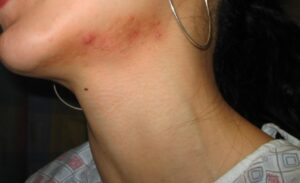By Qiang Zhang, BA, and Peter Lio, MD
Introduction
Music is an important facet of life, with an ability to move us to tears, excite us, calm us, and connect us to our feelings and those of others1. It has been used across different areas of healthcare to meet the emotional, social, and physical needs of individuals2. In medicine, music has been found to have health benefits including reducing stress and anxiety, decreasing pain levels, improving psychosocial symptoms, and increasing host immunity 3–7. Given these benefits, prior work has also explored the connections between music and skin8,9,10,11. In this review, we will discuss some skin-related issues associated with making music, and then how music can potentially help with other skin conditions.
Music-related Maladies
Musicians are at risk for developing a variety of diseases, including musculoskeletal and neurological overuse conditions (e.g., musician’s dystonia)12,13, respiratory conditions14, and psychological issues such as performance anxiety15. A body of recent literature, mostly case reports and cross-sectional surveys, also points to possible skin diseases that could be associated with musicians. For instance, a questionnaire administered to 412 musicians in Germany found that 21.6% of survey respondents had an instrument-related skin disorder, and the most common ones included callosities (58.4%), contact dermatitis (19.1%), fiddler’s neck (19.1%), and erosion (3.4%). (See Table 1.)
Fiddler’s neck
Fiddler’s neck was first described by Peachey and Matthews in 1978 as a condition that affects violinists and violists, and defined as “a localized area of lichenification on the left side of the neck—just below the angle of the jaw”15,16. This is the area where the chin rest normally sits while playing the instrument and can be prone to increased irritation (see Figure 1). Fiddler’s neck has been reported in a 23-year-old female violist, with no history of contact allergy and acne, who developed an erythematous suppurating plaque on the left side of her neck where the instrument rests 17. Another case was in a 24-year-old female violist player who had a round, pruritic plaque on the left side of her neck. She received a patch test and found it to be positive for nickel sulfate18. It has also been reported in self-reported survey studies. One study in Germany found 19.1% of musicians surveyed had Fiddler’s neck19, and another study out of Turkey that surveyed 97 musicians found the prevalence to be 6%20. The mechanism is hypothesized to be allergic or mechanical. Possible allergens that have been identified include exotic woods18,21, propolis22, and metals (nickel, cobalt, and chromium)21. Patch testing can be performed to evaluate for allergic contact dermatitis, but another mechanism is a mechanical reaction induced by friction. The latter can be treated by trying to avoid direct friction with the chin rest via use of a pad or cloth17.

Figure 1. A 26-year-old violinist with mild lichenification indicative of fiddler’s neck along with visible comedones characteristic of acne mechanica. (Photo courtesy of Peter Lio, MD; consent on file.)
Horn Players Lip (“Trumpeter’s wart”)
Brass musicians use their lips to play their instruments, which can lead to friction and breakage of the skin around that area. A case report describes a 69-year-old Italian American male who was noted to have a lesion on his central upper lip23. He reported playing the trumpet since the age of 7 and had this bump since a teenager. This firm, hyperkeratotic lesion reported on the upper lips of trumpeters has been colloquially deemed “Trumpeter’s wart”19. The patient declined treatment, as he remarked needing that contour to create the necessary vibration sounds. Other reports for brass musicians involve a case of irritant contact dermatitis to the lubricant oils to grease the trumpet valves24 and another case of contact allergy to thiuram for a 12-year-old boy who played the trumpet25.
Guitar’s nipple
There is a case report of three girls aged between 8 to 10 who developed a traumatic mastitis of their breast26. All three were learning to play classic guitar, and in each case, the guitar edge of the soundbox was pressed against the nipple. Two patients were right-handed and had right-sided mastitis, while the third patient was left-handed and had left-sided mastitis. Symptoms resolved when they stopped guitar playing. Another case report of a guitarist described allergic contact dermatitis from acrylates in artificial nails in a professional flamenco guitarist 27.
Piano Glissando Purpura
Case reports of pianists with dermatoses are relatively rare in the literature, but there is a case report of a middle-aged Russian pianist who had a localized purpura that affected the second, third, and fourth fingernails of her right hand. The patient described how she had been practicing ascending glissandos passages recently. Glissando is when a player rapidly glides across the keyboard, using the nails and fingers. If too much pressure is applied, it could lead to traumatic damage. The dermatosis resolved for the patient during her follow-up as she had stopped practicing glissandos.
Table 1. Summary of studies on music-related dermatoses
| Author | Population (Country; n) | Type of study | Intervention | Findings |
| (Gambicher et. al. 2008) | Germany; 412 | Cross-sectional study | – Mailed 1-page survey to 19 German universities of music and performing arts to assess frequency and risk factors of instrument-related skin disorders in musicians | – 21.6% of survey respondents had an instrument-related skin disorder including callosities (58.4%), contact dermatitis (19.1%), fiddler’s neck (19.1%), and erosion (3.4%). Instrument-related skin disorders were significantly associated with high practice frequencies (P = 0.022) and a professional status (P = 0.001). |
| (Patruno et al. 2016) | Southern Italy; 628 | Cross-sectional study | – 11-item questionnaire with questions related to instrument played, previous or current skin disorders, and impact of skin symptoms on music was given to musicians in Southern Italy | – 199 (31.7%) reported having at least 1 skin disease. Cutaneous diseases likely directly correlated with the use of the musical instrument were found in 20.5% of the 628 subjects. Diseases found were irritant contact dermatitis (57.0%), callosity (18.4%), and cheilitis (0.8%). |
| (Onder et al. 2001) | Turkey; 97 | Cross-sectional study | – A survey was administered to instrumental musicians and singers that asked about skin changes. Musicians who reported dermatitis were patch-tested. | – Many conditions were reported, including “Fiddler’s neck” (6%), hyperhidrosis (4%), nickel allergy (2%) in musicians, and psoriasis (10%), urticaria (10%), lichen planus (5%), and seborrheic dermatitis (5%) in singers. Positive patch test reactions to nickel and colophony were found in only three patients. |
| (Kraft, 2019) | Germany; 236 | Retrospective study | – A retrospective analysis of the data of the Information Network of Departments of Dermatology (IVDK) was performed, including data from 1997 to 2017. | – In a group of 236 professional musicians, the musicians suffered more frequently from facial dermatitis (23.7% vs 15.7%) and less often from leg dermatitis (5.1% vs 10.7%) than the control group (the non-musicians in the IVDK database). The most frequent diagnoses were allergic contact dermatitis, atopic dermatitis, and irritant contact dermatitis. The prevalence of occupationally related disease is 8.9%. |
| (Warshaw et al. 2021) | US; 59 | Retrospective study | – Retrospective analysis of patch-tested musicians from the North American Contact Dermatitis Group (NACDG) database | – Of 53,707 patch-tested patients, 59 (0.11%) were music professionals. Primary diagnoses were allergic contact dermatitis (49.2%), and irritant contact dermatitis (16.9%). Primary sites of dermatitis were most frequently face (33.9%) or hand (27.1%). Positive patch test allergens include nickel (9.7%), neomycin (7.8%), bacitracin (6.8%), colophonium (5.8%), fragrance mix I (5.8%), and formaldehyde (5.8%). |
Melodies for skin issues
Music therapy has been studied as a form of non-pharmacological complementary therapy for many disorders, including anxiety, depression, schizophrenia, sleep disorders, and dementia 28. It has also been used to reduce the chronic pain burden in cancer patients 29. In the field of dermatology, music therapy has been less extensively studied but it has been found to play a possible role in reducing symptoms of pruritus, decreasing markers of inflammation and stress, and playing a role in dermatological surgeries to reduce patient anxiety30,31. Music therapy has also been raised as a possible treatment that can be useful in the age of COVID to reduce dermatologic disease burden11.
Pruritus
One of the main symptoms of many dermatological diseases is pruritus, a sensation of itching on the skin32. Pruritus strongly reduces quality of life and has been associated with a higher burden of mortality for patients33. Music may be beneficial in treating the symptom of pruritus. In a study done by Dermirtas et al. in 2019, 50 patients in France who had a chronic skin disease (including eczema, psoriasis, and contact dermatitis) were randomized into a music intervention group or a control group that received emollients34. Patients were given two questionnaires to measure pruritus and anxiety levels (Peak Pruritus Numerical Rating Scale and State-Trait Anxiety Inventory Questionnaire) before and after the intervention. The music intervention consisted of the participant listening to personalized music through headphones. The validated ‘U technique’ was employed, which involves a period of stimulating rhythm, a period of slow rhythm, and a period of moderately stimulating rhythm30. Results found a significant reduction of pruritus by 2.3 on a scale of 10, and a non-significant reduction of anxiety by 2.5 on a scale of 80 (p=0.4). Additionally, for patients who received the music intervention, 64% reported feeling an improvement, and 91% would recommend the music intervention. In another study by Burrai et al. in 2014, researchers evaluated the use of live saxophone music for reducing pruritus and pain in hemodialysis patients35. They found a statistically significant reduction in pruritus intensity by 75.7% and significant reduction in pain of 48.1%. Another study by Lazaroff and Shimshoni in 2002 looked at the effect of Magnetic Resonance Therapy Music (MRT-Music) on patients with psoriasis and neurodermatitis. MRT-Music is a therapeutic approach developed by composer and musicologist Peter Hübner that emphasizes particular frequencies designed to heal the body36. Both psoriasis and neurodermatitis patients who listened to MRT showed a reduction in pruritus although the results were not statistically significant.
Allergic Response and DHEA levels
In addition to reducing symptoms of pruritus, music therapy also plays a role in reducing allergic response and dehydroepiandrosterone (DHEA) levels in dermatology patients. A study by Kimata in 2003 had atopic dermatitis participants listen to either Mozart or Beethoven music for 30 minutes. The study found that listening to Mozart, but not Beethoven, significantly reduced allergic wheal response on skin, along with a decrease in production of total IgE, and Th-2 type cytokines interleukin (IL)-4, IL-10, and IL-13. Another study conducted on psoriasis patients found that listening to classical music was associated with a reduction in DHEA-S levels 37. This is significant, as low concentrations of DHEA-S levels have been associated with chronic urticaria 38, and anxiety disorders39. (See Table 2)
Table 2. Summary of studies on music therapy for dermatoses
| Author | Population (Country; n) | Type of study | Skin condition | Intervention | Findings |
| Kimata, 2010 | Japan, 50 | Double-blind randomization to Beethoven or Mozart | Atopic dermatitis | Patients listen to Beethoven or Mozart through speakers of a stereo for 30 minutes | Mozart significantly reduced the one-item overall stress rating scale, wheal responses induced by latex, in vitro production of total IgE and latex-specific IgE, decreased production of Th-2 type cytokines IL-4, IL-10, and IL-13, and increased Th-1 type cytokines (IFN-y, IL-12), while these effects were not found for Beethoven (p<.001). |
| Burrai et al. 2014 | Italy, 114 | Randomized control trial | Pruritus | Patients undergoing hemodialysis received either 30 minutes of live saxophone music therapy or a 30-minute rest period | Patients listening to live music showed statistically significant improvement in pruritus symptoms, reduction in pain level, and improvement in oxygen saturation (p<.001). |
| Dermitas et al. 2019 | France, 50 | Randomized control trial | Psoriasis, atopic dermatitis, contact eczema, drug-induced dermatitis, pruritus sine materia, prurigo nodular, bullous pemphigoid, unknown | 50 inpatients with chronic skin diseases were randomized to a music group that received a 20-minute individualized music session using the “U technique” via headphones or a control group that received an application of emollient cream | Music intervention significantly decreased intensity of pruritus (pruritus 10-pt score change – 2.3 ± 2.1 vs. control – 1.2 ± 1.7, p < 0.05), non-significantly reduced anxiety (p=0.4). 64% reported feeling improvement, 91% recommend music intervention, 64% would like to continue music intervention |
| Lazaroff and Shimshoni, 2000 | Germany, 68 | Experimental group vs. control | Psoriasis vulgaris, neurodermatitis | Experimental group of patients in hospital received 3×30 minutes of MRT-Music | Patients who received MRT music showed reduced degree of sickness (psoriasis, average reduction with music: 65% vs. control 20%; neurodermatitis, average reduction with music: 41% vs. control 12%), reduced stimulus to scratch (psoriasis, average reduction with music: 86% vs. control 29%; neurodermatitis, average reduction with music: 59% vs. control 14%), reduced heart rate and blood pressure. |
| Krasinski-Heringa et al. | Poland, 27 | Within-subjects design | Psoriasis
|
Patients listened to preselected list of classical music for 30 min | Patients showed an increase in DHEA-S levels after listening to classical music, but no significant changes in anxiety levels |
Based on a table from Riew et al. 2023.
*MRT- Music = Medical Resonance Therapy Music
Conclusion
There are many fascinating aspects in the relationship between music and the skin. In this brief review, we’ve looked at various dermatoses found in musicians, as well as the effects of music on some dermatoses. We’ve found that there are common conditions found in musicians, such as allergic contact dermatitis, mechanical-induced dermatitis, and hyperkeratosis. These skin conditions are aptly categorized according to which instrumentalist they affect: i.e., “Fiddler’s neck”, “Guitar’s nipple”, or “Trumpeter’s wart.” On the music therapy side of the literature, we also found that music has effects on reducing pruritus levels, allergy responses, and DHEA levels. As only a few studies were found, it would be useful in the future to study how other forms of musical interventions, such as songwriting or singing, could impact outcomes. Overall, music could be considered a highly accessible and very safe intervention for some dermatologic conditions, and further research is warranted.
About the authors

Qiang Zhang, BA
Qiang Zhang, BA, is a third-year medical student at the David Geffen School of Medicine at the University of California, Los Angeles School of Medicine.
DISCLOSURES: None

Peter Lio, MD
Peter A. Lio, MD is a Clinical Assistant Professor of Dermatology and Pediatrics at Northwestern University Feinberg School of Medicine and a partner at Medical Dermatology Associates of Chicago.
DISCLOSURES:
Dr. Lio reports research grants/funding from AbbVie, AOBiome, Eczema Foundation, National Eczema Association; is on the speaker’s bureau for AbbVie, Eli Lilly, Galderma, Hyphens Pharma, Incyte, La Roche-Posay/L’Oreal, MyOR Diagnostics, ParentMD, Pfizer, Pierre-Fabre Dermatologie, Regeneron/Sanofi Genzyme; reports consulting/advisory boards for AbbVie, Almirall, Amyris, Arbonne, Arcutis, ASLAN, Boston Skin Science, Bristol-Myers Squibb, Burt’s Bees, Castle Biosciences, Codex Labs, Concerto Biosci, Dermavant, DermVeda, Eli Lilly, Galderma, IntraDerm, Janssen, Johnson & Johnson, Kaleido Biosci, Kimberly Clark, LEO Pharma, Lipidor, L’Oreal, Menlo Therapeutics, Merck, Micreos, MyOR Diagnostics, Regeneron/Sanofi Genzyme, Skinfix, Sonica, Theraplex, UCB, Unilever, Verrica, Yobee Care; stock options: Micreos, Modernizing Medicine, Yobee Care. In addition, Dr. Lio has a patent pending for a Theraplex product with royalties paid and is a Board member and Scientific Advisory Committee Member of the National Eczema Association.
References:
- Reflections on music, affect, and sociality. In: Progress in Brain Research. Vol 237. Elsevier; 2018:153-172.
- Contreras JA. Music as Medicine: A Concept Analysis. Creat Nurs. 2022;28(4). doi:10.1891/CN-2022-0034
- Guzzetta CE. Effects of relaxation and music therapy on patients in a coronary care unit with presumptive acute myocardial infarction. Heart Lung. 1989;18(6). Accessed October 21, 2023. https://pubmed.ncbi.nlm.nih.gov/2684920/
- White JM. Effects of relaxing music on cardiac autonomic balance and anxiety after acute myocardial infarction. Am J Crit Care. 1999;8(4). Accessed October 21, 2023. https://pubmed.ncbi.nlm.nih.gov/10392221/
- Burns SJ, Harbuz MS, Hucklebridge F, Bunt L. A pilot study into the therapeutic effects of music therapy at a cancer help center. Altern Ther Health Med. 2001;7(1). Accessed October 21, 2023. https://pubmed.ncbi.nlm.nih.gov/11191042/
- Schneider N, Schedlowski M, Schürmeyer TH, Becker H. Stress reduction through music in patients undergoing cerebral angiography. Neuroradiology. 2001;43(6). doi:10.1007/s002340000522
- Mofredj A, Alaya S, Tassaioust K, Bahloul H, Mrabet A. Music therapy, a review of the potential therapeutic benefits for the critically ill. J Crit Care. 2016;35. doi:10.1016/j.jcrc.2016.05.021
- Wan AY, Biro M, Scott JF. Pharmacologic and Nonpharmacologic Interventions for Perioperative Anxiety in Patients Undergoing Mohs Micrographic Surgery: A Systematic Review. Dermatol Surg. 2020;46(3):299.
- Gamboa J, Cameron MC, Fathi R, Alkousakis T. A review of non-pharmacologic approaches to enhance the patient experience in dermatologic surgery. Dermatol Online J. 2020;26(3). doi:10.5070/D3263048028
- Oska C, Nakamura M. Alternative Psychotherapeutic Approaches to the Treatment of Eczema. Clin Cosmet Investig Dermatol. 2022;15. doi:10.2147/CCID.S393290
- Murrell DF, Kroumpouzos G, Gupta A, di Lernia V, Sadoughifar R, Goldust M. Role of music therapy in reducing the burden of dermatological diseases during COVID-19. Dermatol Ther. 2020;33(6). doi:10.1111/dth.14086
- Gómez-Rodríguez R, Díaz-Pulido B, Gutiérrez-Ortega C, Sánchez-Sánchez B, Torres-Lacomba M. Prevalence, Disability and Associated Factors of Playing-Related Musculoskeletal Pain among Musicians: A Population-Based Cross-Sectional Descriptive Study. Int J Environ Res Public Health. 2020;17(11). doi:10.3390/ijerph17113991
- Rozanski VE, Rehfuess E, Bötzel K, Nowak D. Task-Specific Dystonia in Professional Musicians: A Systematic Review of the Importance of Intensive Playing as a Risk Factor. Deutsches Ärzteblatt International. 2015;112(51-52):871.
- Niarchou M, Lin GT, Lense MD, Gordon RL, Davis LK. Medical phenome of musicians: an investigation of health records collected on 9803 musically active individuals. Ann N Y Acad Sci. 2021;1505(1):156.
- van Kemenade JF, van Son MJ, van Heesch NC. Performance anxiety among professional musicians in symphonic orchestras: a self-report study. Psychol Rep. 1995;77(2). doi:10.2466/pr0.1995.77.2.555
- Peachey RDG, Matthews CNA. “Fiddler’s neck’. Br J Dermatol. 1978;98(6):669-674.
- Moreno JC, Gata IM, García-Bravo B, Camacho FM. Fiddler’s neck. Am J Contact Dermat. 1997;8(1). doi:10.1016/s1046-199x(97)90035-x
- Jue MS, Kim YS, Ro YS. Fiddler’s Neck Accompanied by Allergic Contact Dermatitis to Nickel in a Viola Player. Ann Dermatol. 2010;22(1):88.
- Gambichler T, Uzun A, Boms S, Altmeyer P, Altenmüller E. Skin conditions in instrumental musicians: a self-reported survey. Contact Dermatitis. 2008;58(4). doi:10.1111/j.1600-0536.2007.01310.x
- Onder M, Aksakal AB, Oztaş MO, Gürer MA. Skin problems of musicians. Int J Dermatol. 1999;38(3). doi:10.1046/j.1365-4362.1999.00656.x
- Pincelli C, Motolese A, Pincelli L. Fiddler’s neck and nickel dermatitis. Contact Dermatitis. 1985;13(1). doi:10.1111/j.1600-0536.1985.tb02492.x
- Lieberman HD, Fogelman JP, Ramsay DL, Cohen DE. Allergic contact dermatitis to propolis in a violin maker. J Am Acad Dermatol. 2002;46(2 Suppl Case Reports). doi:10.1067/mjd.2002.106349
- Milgraum S, Gold E, Milgraum DM. The musician’s mark. JAAD Case Reports. 2018;4(8):772.
- Haroun-Díaz E, Rodrigues-Barata R, Cuesta-Herranz J, Conde-Salazar L. Contact Dermatitis due to Lubricant Oils in a Brass Musician. Ann Dermatol. 2017;29(1):127.
- Hallai N, Meirion Hughes T, Stone N. Contact allergy to thiuram in a musician. Contact Dermatitis. 2004;51(3):154-154.
- Curtis P. Letter: Guitar nipple. Br Med J. 1974;2(5912):226.
- Alcántara-Nicolás FA, Pastor-Nieto MA, Sánchez-Herreros C, et al. Allergic contact dermatitis from acrylic nails in a flamenco guitarist. Occup Med . 2016;66(9). doi:10.1093/occmed/kqw158
- Wang S, Agius M. The use of Music Therapy in the treatment of Mental Illness and the enhancement of Societal Well-being. Psychiatr Danub. 2018;30(Suppl 7). Accessed October 22, 2023. https://pubmed.ncbi.nlm.nih.gov/30439854/
- Stanczyk MM. Music therapy in supportive cancer care. Reports of Practical Oncology and Radiotherapy. 2011;16(5):170.
- Masson E. Évaluation et standardisation d’une nouvelle technique de musicothérapie dans la prise en charge de la douleur : le montage en « U ». EM-Consulte. Accessed October 22, 2023. https://www.em-consulte.com/article/269150/evaluation-et-standardisation-dune-nouvelle-techni
- Riew GJ, Kamal K, Hijaz B, Awh KC, Nambudiri VE. Clinical music interventions and music therapy in dermatology. Arch Dermatol Res. 2023;315(9):2485-2490.
- Rupert J, Honeycutt JD. Pruritus: Diagnosis and Management. Am Fam Physician. 2022;105(1). Accessed October 22, 2023. https://pubmed.ncbi.nlm.nih.gov/35029946/
- Weisshaar E. Itch: A Global Problem? Frontiers in Medicine. 2021;8. doi:10.3389/fmed.2021.665575
- Demirtas S, Houssais C, Tanniou J, Misery L, Brenaut E. Effectiveness of a music intervention on pruritus: an open randomized prospective study. J Eur Acad Dermatol Venereol. 2020;34(6). doi:10.1111/jdv.16149
- Burrai F, Micheluzzi V, Zito MP, Pietro G, Sisti D. Effects of live saxophone music on physiological parameters, pain, mood, and itching levels in patients undergoing haemodialysis. J Ren Care. 2014;40(4). doi:10.1111/jorc.12078
- SCIENTIFIC MUSIC MEDICINE – World Health Organisation. Accessed October 22, 2023. https://www.peterhuebner.com/01/05_News/0503_WHO.php
- Krasiński-Heringa O, Owczarek W, Kozłowska M, et al. The effects of listening to classical music on dehydroepiandrosterone sulfate and subjective anxiety levels in female in-patients with psoriasis. Przegl Dermatol. 2019;106(1):92-94.
- Kasperska-Zajac A. Does Dehydroepiandrosterone Influence the Expression of Urticaria?—a Mini Review. Inflammation. 2011;34(5):362.
- Gill J, Vythilingam M, Page GG. Low cortisol, high DHEA, and high levels of stimulated TNF-alpha, and IL-6 in women with PTSD. J Trauma Stress. 2008;21(6). doi:10.1002/jts.20372


